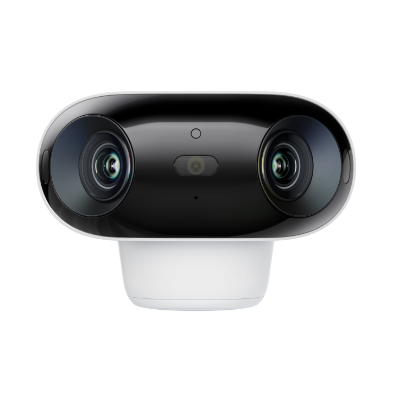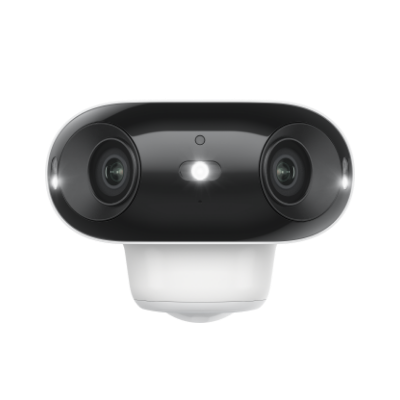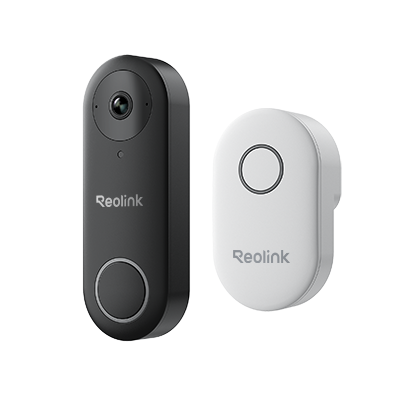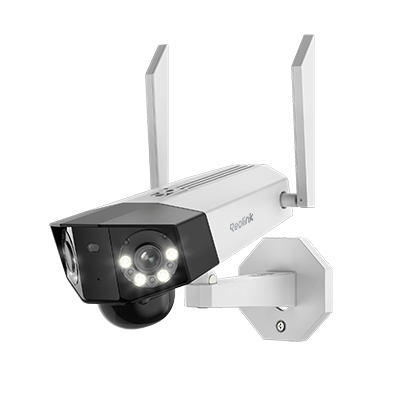180-Degree Security Camera: All You Need to Know
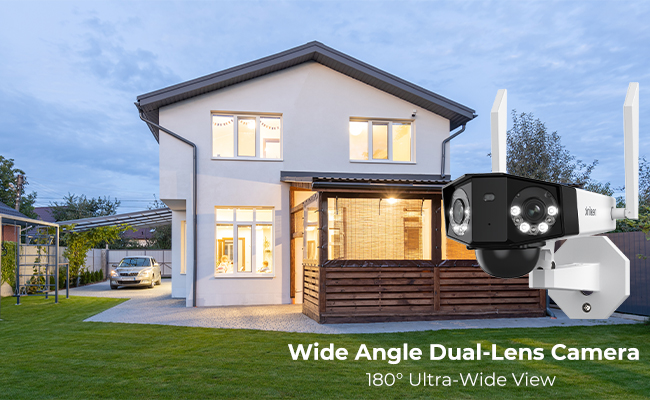
A wide field of view (FOV) is one of the basic qualities that a good security camera should have. As you may have guessed, a wide field of view, especially with a 180-degree security camera, allows the camera to capture more area in one shot, which is very useful for surveillance.
You have different options when it comes to choosing the view angle (FOV) of a security camera, and in this article we are going to cover the 180-degree security camera and everything you need to know about it.
- What is the 180-degree security camera?
- Benefits of 180-Degree Security Camera
- How the 180-Degree Security Camera Works
- Common Applications of 180-Degree Security Cameras
- What Should You Consider When Buying a 180-Degree Security Camera?
- Best Picks for 180-Degree Security Camera
- Other Wide-Angle Camera Options Besides 180-Degree?
- FAQs
- Conclusion
What is the 180-degree security camera?
A 180-degree security camera is a surveillance camera with an ultra-wide (usually fisheye) lens. As the name implies, these cameras can capture a 180-degree view of what is happening in their surroundings.
These cameras are typically used for security purposes due to the extensive view of the area around them and can help to deter crime or capture footage of any incidents that occur.
You will find this camera especially helpful if you have a large property or need to keep an eye on multiple entrances. 180-degree cameras offer clear and consistent image quality, even in low light conditions. And because they don't require panning or tilting, they're much easier to install and maintain than traditional security cameras.
Benefits of 180-Degree Security Camera
- Wide monitor area A wider field of view lets the camera get more information from a scene. This is the primary benefit of these types of cameras, which means the camera will be able to monitor large portions of areas with fewer blind spots. This makes them highly effective in parking lots, warehouses, your home driveway, etc.
- High efficiency This would translate to lower costs if you are trying to watch an expansive area. Rather than using multiple cameras with smaller FOVs, you could use one or just a few 180-degree security cams to cover the same large area, saving you extra costs on purchasing and maintaining cameras.
- High resolution and more detail. Another significant benefit is the camera's resolution and high level of detail. Because of the 180-degrees security camera's application in surveillance, manufacturers are now equipping their products with the ability to record in high-res. This feature is handy for facial recognition and identifying license plates of suspicious vehicles.
How the 180-Degree Security Camera Works
There are two ways to achieve 180-degree FOV with a 180-degree security cam. One is using a fisheye lens and the other is using multiple lenses stitching together the video.
Fisheye lens 180-degree camera
A 180-degree fisheye CCTV camera is a great option for surveillance because it offers a wide angle of view. This type of camera is especially beneficial in areas where there is a lot of activity, as it can capture a larger area than a traditional camera.
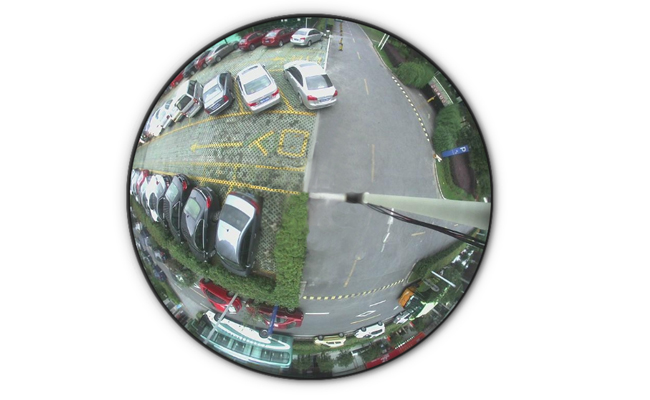
Fisheye lenses can be used with both analog and digital cameras, and they are available in various sizes and focal lengths.
Multiple lenses 180-degree camera
Another method of achieving 180 degree ultra-wide FOV is with multiple lenses. For instance, when using two lenses, the multi-lens 180-degree camera receives footage from both lenses watching the same area simultaneously and uses video stitching to generate single footage covering an extensive-angle of view.
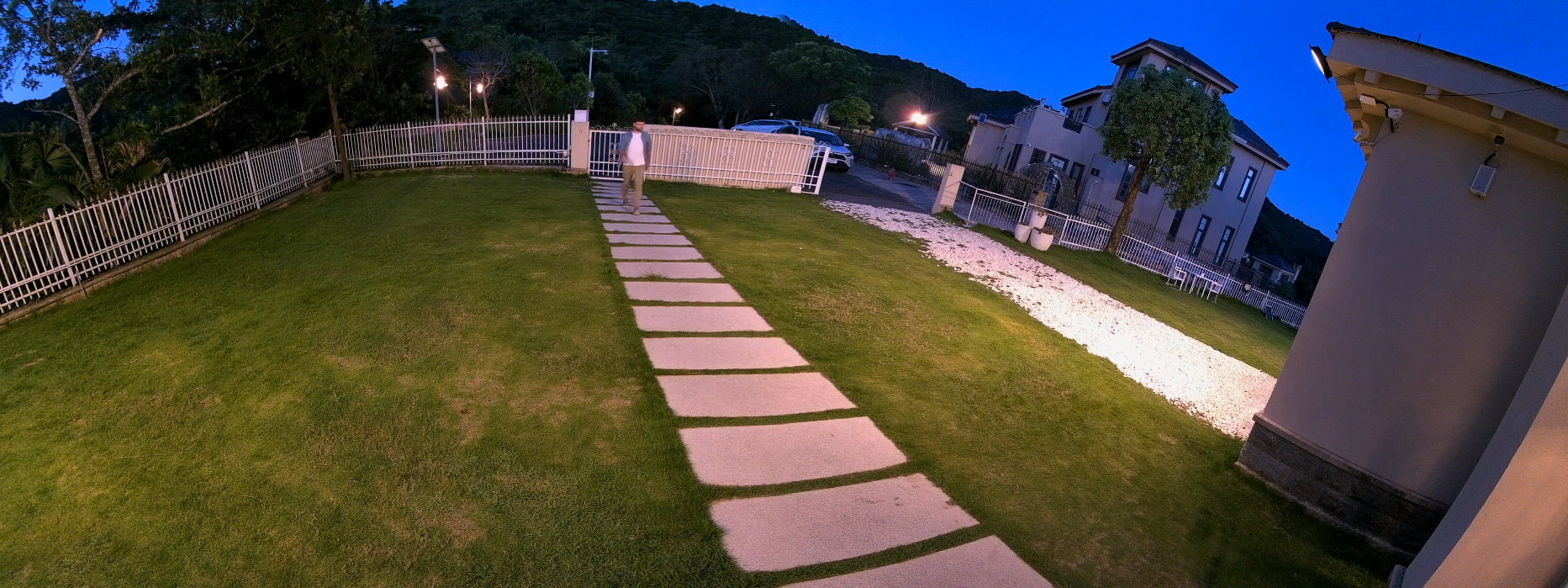
A front lawn is captured in a 180-degree wide angle view by the Reolink Duo camera. The camera has two lens, one on the left and one on the right, which allows it to capture a 180-degree field of view. This is a great way to get an overview of your property, and it's also useful for security purposes.
Common Applications of 180-Degree Security Cameras
These security cameras' ability to record with a wide field of view makes them suitable for use in different indoor and outdoor settings.
Doorbell cameras
One typical use is to install 180-degree security cams at the front door to monitor movement at your doorstep. Even from your door, the cameras can still cover a large portion of their surroundings, thanks to their wide FOV.
A doorbell cam is a great way to keep an eye on your doorstep. A 180 degree security cam at your door can help deter criminals and generally keep an eye on what is happening outside your door, especially for the safety of your delivery package. The 180 degree wide angle doorbell cam gives you peace of mind and the assurance that your doorstep is constantly monitored.
Indoors
180-degrees security cameras also work well in walled areas. To get the best out of them, though, they must be used in spacious indoor areas like warehouses, cafeterias, hotels, hallways and more.
Outdoors
The outdoors are where 180-degree security cams shine best. Their wide-angle lens is more effective than those of a traditional camera and provides video footage with dynamic viewing angles. With 180-degree cams, there are fewer blind spots, and the camera can provide better coverage without needing extra cameras.
Usually, these cameras are often designed with night vision and made to be weather resistant, so using them outside can be as easy as possible.
Examples of outdoor locations the cameras can be used include parking lots, yards, farms, etc.
What Should You Consider When Buying a 180-Degree Security Camera?
1. Resolution
When you're looking to buy a 180-degree camera, the resolution is one of the most important factors to consider. The resolution of a camera dictates how many pixels are captured in an image, and higher resolutions result in sharper, more detailed images.
You'll generally want to look for a camera with at least 5MP resolution for the best results. However, the resolution isn't the only thing to keep in mind when choosing a camera; you'll also want to consider the field of view, sensor size, and other factors.
2. Weather resistance
Since 180-degree security cams are best used outdoors, you must ensure your pick can keep working in unfriendly weather conditions.
A camera's weather resistance is often measured by the IP rating. An IP rating is usually the letters 'IP' followed by two digits (between 0 and 6). It would be best if you always looked for products with ratings of at least IP55 and above to be guaranteed protection from dust and water.
Some cameras are also fitted with temperature gauges and heaters to let them operate in extreme temperatures.
3. Tamperproof
Durability is key for 180-degree camera security. They need to be able to withstand damage from external sources, both natural and human. This is important if you use a 180-degree camera for outdoors, as it will need to resist damage from the elements.
How well a camera can resist impact is measured by its IK rating. The IK rating of a device ranges between 0 and 10, and a good 180-degree camera should have between IK08 and IK10 rating.
4. Night vision
This allows the camera to continue to record in low light situations.
Night vision is another essential quality for security cameras, so it should be prioritised. Such cameras often have infrared emitters, which you should look for when picking a 180-degree security cam.
5. NVR compatibility
A network video recorder (NVR) is a system that encodes and processes data at the camera before transmitting it to the recorder for storage and remote viewing.
It is the successor of the older digital video recorder (DVR) systems which converts analog footage to digital data.
NVRs are better than DVRs because they can record better image quality, including video and audio, facial recognition and other advanced features. So make sure that the 180-degree camera you choose can work with NVR without any problem.
6. Smart motion detection
Ideally, you want to ensure your camera can distinguish between an actual security threat and background distraction.
This is where intelligent detection comes into play. Smart/intelligent camera detection systems can differentiate a human target, a vehicle, and even a pet, which allows them to filter out irrelevant recordings efficiently.
The motion detection system works in hand with smart detection and starts working as soon as it detects the motion of a relevant target.
Some cameras also allow you to set up specific areas that you want to be monitored for motion. For example, you might want to focus the camera on your front door or a vulnerable window. When configuring your camera, you'll need to decide how sensitive you want the motion detector to be. If it's too sensitive, it will trigger false alarms; if it's not sensitive enough, it might miss actual events.
Best Picks for 180-Degree Security Camera
1. Reolink Argus 4 Pro security camera
Argus 4 Pro is a 4K 180-degree wireless security camera. This camera boasts two lenses, allowing it to capture an expansive 180⁰ super wide view. With this wide field of vision, you can monitor a larger area without blind spots.
The Reolink Argus 4 Pro also features ColorX technology, which incorporates an F10 aperture to enhance low-light performance and provide better video quality during nighttime surveillance. And this technology eliminates the common challenges associated with IR night cameras. According to laboratory testing data, it allows you to save 2W/h per hour, resulting in up to 12 additional days of standby time.
4k 180° Wire-free Color Night Vision Camera
4K UHD 180° Blindspot-free View; Color Vision Day and Night; 30% More Battery Life; Dual-band Wi-Fi 6; Smart detection.
If you want an inexpensive 180-degree security camera that still performs well, the Argus 4 standard version is worth considering.
4k 180° Blindspot-free Wi-Fi 6 Camera
4K UHD 180° Blindspot-free View; Dual-band Wi-Fi 6; Smart detection; Easy Installation Anywhere
2. Reolink doorbell with chime
The Reolink doorbell camera with chime has everything you need for a capable wide-angle security camera, including excellent resolution (5MP), an intelligent detection system, and night vision.
It goes beyond the regular doorbell cameras as it allows you to communicate with whoever is at your doorstep from any room in your home.
Installation is also easy; since it's PoE-enabled, you can power it using the same Ethernet cables you use to connect your security cameras - no additional wiring is required.
Smart 5MP Video Doorbell with Chime
5MP Super HD, Person Detection, Power over Ethernet, 180° Diagonal Viewing Angle, Two-Way Audio, High-Quality Night Vision.
3. Reolink duo 2 dual lens security camera
like our previous mention, this camera also uses two lenses and stitches both views for 180° panorama footage.
In terms of similarities, this camera offers night vision, a slightly better smart detection system, and weather resistance (IP66 rating).
It also uses the latest NVR technologies to provide more advanced capabilities.
Smart 2K+ Dual-Lens Battery Camera
6MP Super HD, Person/Vehicle Detection, 180° Wide Viewing Angle, Battery/Solar Powered, Dual-Band WiFi, Color Night Vision.
Other Wide-Angle Camera Options Besides 180-Degree?
Wide angle security cameras are a great option for general surveillance as they can cover more area than standard security cameras. Besides 180 degree security cameras, there are other wide angle cameras available as well.
There are several different types of wide angle security cameras on the market, including omnidirectional cameras, zoom lens cameras, and PTZ cameras.
Omnidirectional (360-degree) camera
This kind of camera has a FOV that records in a full circle around a horizontal plane.
Like the 180-degrees camera, it is also suitable for large areas, and its wide viewing angles are made possible via several methods. It could be with a single lens, dual fisheye lens, more than two lenses, or a camera rig like GoPro.
Varifocal lens security camera
Varifocal lens cameras can adjust their focal length, angle of view and level of zoom. They usually have the manual zoom ability, allowing you to determine the best viewing angle possible, without losing great deal of footage detail.
This means that wide-angle surveillance cameras with varifocal lenses do better to zoom out to cover large areas and zoom in to capture small details.
PTZ cameras
PTZ (pan, tilt, zoom) cameras could be technically regarded as wide-angle cameras. This is because these cameras have mechanical parts that let them swivel horizontally, tilt vertically and zoom in and out. Their design allows them to have a wider FOV than regular cameras.
However, PTZ cameras can be more expensive and may require more maintenance than standard or wide-angle security cameras
FAQs
How far can a 180-degree camera see?
The answer depends on a few factors, including the camera's resolution and the sensor's size. Generally speaking, 180-degree cameras can see anywhere from 10 to 20 feet away. However, higher-end models may have a more range than the lower-quality ones.
Can a camera see 180 degrees?
Not all cameras can; only ultra-wide cameras are capable of viewing angles of 180 degrees and above. The ultra-wide FOVs are typically achieved using two lenses or a unique fisheye lens. Thanks to the advanced dual-lens stitching technology, Argus 4 Pro falls into this category. This camera has 180° field of view, which helps you eliminate blind spot.
What is the best angle for a security camera?
There is no definitive answer to this question. Your needs would help you choose the best angle for a security camera. Ultimately, the best angle for a security camera is the one that provides you with the coverage you need to feel safe and secure.
If you have a large home or property, you may want to consider using multiple cameras with different fields of view to get comprehensive coverage.
Alternatively, if you only need to monitor a small area, a camera with a narrower field of view may be sufficient. No matter your particular needs, a security camera out there will provide you with the coverage you need.
How many degrees can CCTV record?
Most CCTV cameras can record anywhere from 24 to 32 degrees. The field of view (FOV) will determine how many different objects the camera can see at once. While most home security cameras have a FOV of between 45 and 90 degrees, some can have a FOV as wide as 180 degrees. This allows the camera to see a larger area, but it also means that objects in the distance will appear smaller.
For this reason, it's crucial to choose a CCTV camera with a FOV that is appropriate for the area you want to monitor.
Conclusion
180-degree security cameras are a great way to bolster your home or business security. Their wide FOVs reduce the number of blind spots for your camera, making it easy to see what is happening around the property. They also allow you to record footage of any activity, providing valuable evidence in the event of a break-in or any other incident.
Getting a 180-degree camera doesn't automatically solve your problems, though. You have to make sure you pick the right one for your needs so they can work efficiently.
If you have any questions, don't hesitate to leave a comment or share this article with your friends. Thanks for reading!
Search
Be in the Know
Security insights & offers right into your inbox

